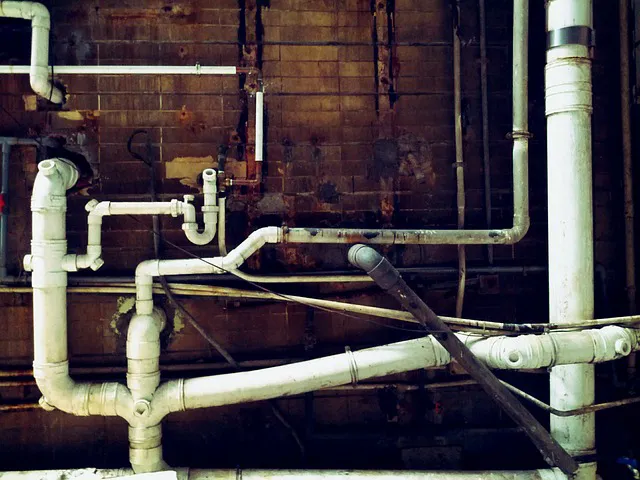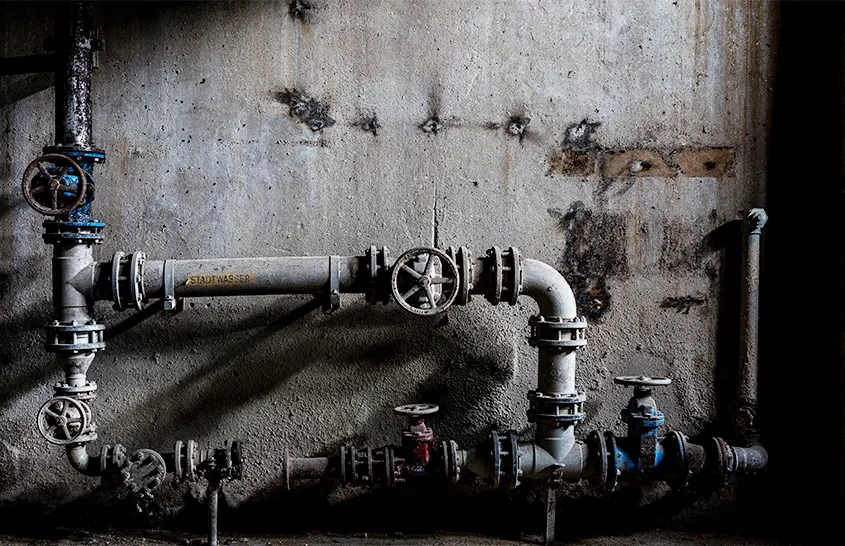Are the water pipes installed in your house old or outdated? Then you should urgently consider renovating them!
Old water pipes pose an enormous risk to the health of tap water users. The severity of this danger is often underestimated. Frequently unawareness of the involved risks is the reason people neglect to renovate or replace old water pipes.
Drinking water is probably the most important food in the world. For this reason, great importance is attached to water quality. The Drinking Water Ordinance ensures through strict regulations that only meticulously treated water enters the supply network. Nevertheless, consumers are not necessarily on the safe side when they obtain this water. Old water pipes can counteract or even cancel out the efforts of the waterworks. A simple water analysis for private households can show whether renovation is necessary. Find out here if and why you should make sure that there are no more old water pipes in your house:
Can old water pipes make you sick?
If we ingest heavy metals or bacteria and germs with our drinking water, there can be considerable consequences for our health.
The problem is often that complaints, symptoms and illnesses are not associated with contamination of the tap water or only at a late stage. Especially for babies, children and immunocompromised people, contaminated water poses a threat and can cause long-term health consequences.
For example, the ingestion of lead in drinking water can lead to cyanosis in babies which can result in illnesses and even underdevelopment of the child. Bacteria and germs also inflict long-term damage on the consumer. It is possible, for example, that long-lasting diarrhea, triggered by coliform bacteria, can lead to impairment of the general health and development of children.
The possible complaints and illnesses that can be triggered by dangerous substances and bacteria in water are very diverse. They are easily mistaken for other diseases, while the contaminated drinking water continues to be consumed. To be sure that the cause of the ailment is not related to the drinking water, experts therefore recommend regular water analyses for private households as well – especially if older domestic plumbing is used or the water is obtained with the help of a private domestic well.
Old water pipes – some of the biggest dangers:
Lead pipes

Until the early 1970s, it was common to use lead pipes for domestic drinking water installations. Since then, however, it has been known that toxic lead dissolves from the pipes and gets into the water. Lead in water is particularly dangerous for unborn children as well as babies and toddlers. Long-term complaints and illnesses are not uncommon. But adults can also suffer from lead-contaminated water, often unnoticed for a long time. Landlords are also obliged to ensure that the lead limit value according to the Drinking Water Ordinance is complied with. If old water pipes made of lead are still installed, this is hardly possible. Tenants have the right to have the affected pipes replaced.
Copper pipes
Copper water pipes are still very common. Under certain circumstances, however, copper can dissolve from the pipes. This danger exists above all when the pH value is below 7. But even if the pH is not below this value, new copper pipes in particular can release increased amounts of copper into the water during the first few months of use. Copper can lead to liver damage, especially in babies and small children. The use of water for the preparation of baby food should therefore be avoided.
Stagnation, e.g. due to dead pipes or rarely used water pipes
The longer water stands in the pipe, the more substances it absorbs from pipes and fittings. The tap is also a source of danger here: it is not uncommon for nickel from alloys to get into the water here. If the water temperature is higher than 20 degrees Celsius, the long standing time in rarely used pipes favors the formation of bacteria and germs.
Insufficient heating of the hot water
Bacteria and germs multiply at an enormous rate at lukewarm temperatures. The hot water system, including the hot water tank, is therefore a source of danger. Legionella and other bacteria may find excellent conditions to spread here.
Old water pipes are a problem that is rarely taken into account. Consumers, especially children and babies, often suffer from diarrhea. Parents and those affected often only become aware of possible contamination of the drinking water, for example through old water pipes, at a very late stage, if at all.
How can I recognize old water pipes?
If old water pipes are installed in your house, they are usually lead pipes. These are quite easy to distinguish from modern materials. Both the appearance and the material consistency of old lead pipes are very distinctive.
Lead pipes are also not screwed together, as is often the case with other materials. The pipe diameter often varies and joints between two pipes have beads. In addition, the pipes, unless they have been painted over, have a typical lead-grey color. The material can be easily scratched with the help of a screwdriver. Lead is also non-magnetic and sounds rather dull when tapped with a hammer, for example. In earlier times, when lead pipes were still common, they were laid in relatively wide bends, especially in cellars, whereas new materials can be laid much more flexibly.
Copper pipes usually have a rather small diameter and the typical copper-red color. Their color makes them relatively easy to recognize, even for the amateur.
If other materials are used, it is worth seeking the advice of an expert to determine whether the pipes need to be replaced.
When do outdated water pipes need to be replaced?
Old water pipes need to be replaced primarily when substances dissolve and get into the drinking water. Another inevitable factor is the formation of biofilms, if these can no longer be removed by a specialist. This is because bacteria and germs find ideal breeding conditions here.
Especially if lead pipes are laid in the house and carry drinking water, remediation is unavoidable. The probability of complying with the limit values for lead specified in the Drinking Water Ordinance is minimal if the water flows through lead pipes.
Remediation also becomes an issue when dead pipes become a problem. Bacteria and germs accumulate here, turning the rarely or never used pipes into breeding grounds.
In any case, it is worthwhile to have an expert assess the relevance of a pending renovation. A water analysis of the water that ultimately flows out of the tap is also recommended. These analyses show whether heavy metals are detached from water pipes and thus get into the water we use for cooking and drinking. microbacterial contamination and pollution can also be quickly and reliably detected by a water test. In this way, it can be determined with little effort whether a comprehensive renovation of the pipes is necessary. Even if more modern materials have been used for the domestic installation, the risk of contamination cannot be ruled out.
Not only old water pipes endanger our drinking water
Enormous efforts are often necessary to ensure that water suppliers can deliver high-quality water without exception. After all, the quality of the tap water, which is largely obtained from groundwater, suffers not least from the pollution for which we ourselves are responsible. This includes, for example, nitrate and pesticides, which are applied in large quantities by agriculture and in some cases end up in the groundwater. Extensive treatment steps are necessary to ensure that these hazardous substances no longer appear in later drinking water and that the quality characteristics specified by the Drinking Water Ordinance are met.
In order to avoid this effort, the drinking water user has little room for flexibility and must mainly rely on the water suppliers to fulfill their duty to maintain the quality of the drinking water. The fact is that ultimately only high-quality drinking water reaches households’ pipes, even if treatment is becoming more and more expensive.
Many consumers do not realize that the responsibility for the quality of the water is transferred to the owner of the property at the transfer point, the water meter. From here on, the owner is responsible for compliance with all the limits set out in the Drinking Water Ordinance. If drinking water flows through old water pipes, various toxins can dissolve and get into the water. These can have a lasting effect on the health of the consumer.
A simple water test provides certainty
A simple and effective way to find out whether one’s own water pipes are responsible for complaints or whether there are dangers lurking here is to have a water test carried out by a professional laboratory. This water analysis also enables private households to find out whether their own tap water is contaminated. Find out more about the water test you can carry out yourself in the IVARIO shop.


